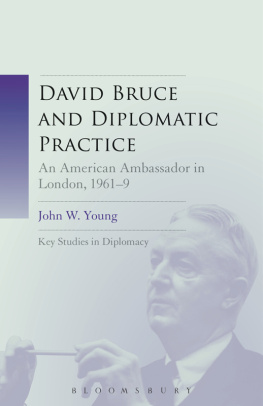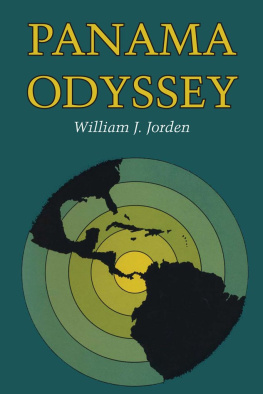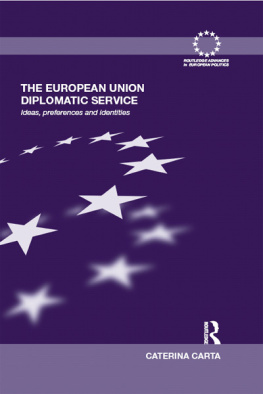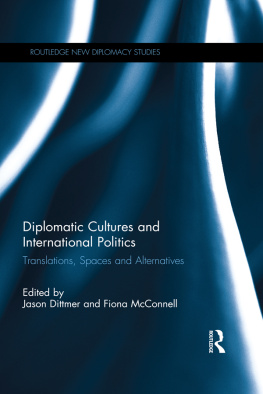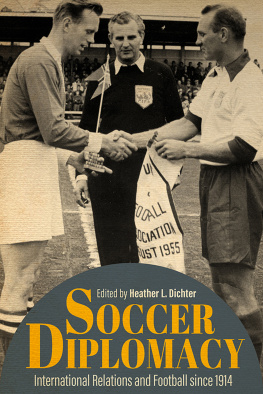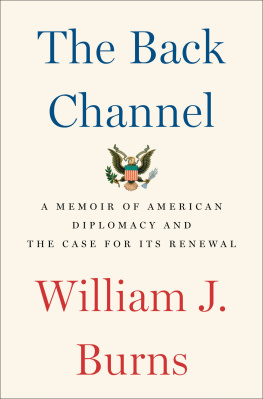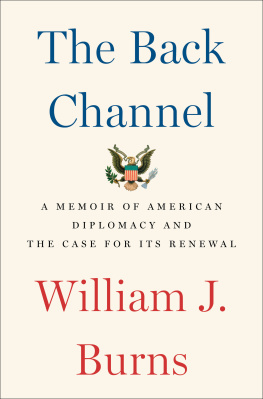David Bruce and Diplomatic
Practice
About the Series
Key Studies in Diplomacy is an innovative series of books on the procedures and processes of diplomacy, focusing on the interaction between states through their accredited representatives, that is, diplomats. Thus, its volumes focus on factors affecting foreign policy, and the ways in which it is implemented, through the apparatus of diplomacy the diplomatic system in both bilateral and multilateral contexts. But they also examine how diplomats are sometimes able to shape not just the presentation but also the substance of their states foreign policies. Given that the diplomatic system is worldwide, all the series volumes, whatever their individual focuses, contribute to an understanding of the nature of diplomacy. They do so authoritatively in that they are written by scholars specializing in diplomacy and by former diplomats and comprehensibly. They emphasize the actual practice of diplomacy, and analyse that practice in a clear and accessible manner, hence making them essential primary reading for both beginning practitioners and advanced-level university students.
Series Editors
J. Simon Rofe and Giles Scott-Smith
Lorna Lloyd (Editor Emeritus)
Other Titles in the Series
21st Century Diplomacy by Kishan S. Rana
Embassies in Armed Conflict by G. R. Berridge
David Bruce and Diplomatic
Practice
An American Ambassador in London, 19619
John W. Young
To my good friends
Geoffrey Berridge
Nicholas Cull
Michael Dockrill
Michael Hopkins
Contents
BDOHP | British Diplomatic Oral History Project |
CFUK | Country File, United Kingdom |
CIA | Central Intelligence Agency |
CRO | Commonwealth Relations Office |
DBD | David Bruce Diary |
EEC | European Economic Community |
FAOHC | Foreign Affairs Oral History Collection |
FCO | Foreign and Commonwealth Office |
FO | Foreign Office |
FRUS | Foreign Relations of the United States |
JFKL | John F. Kennedy Library |
LBJL | Lyndon B. Johnson Library |
MI5 | British Counter-Intelligence and Counter-Subversion Service |
MI6 | British Secret Intelligence Service |
MLF | Multilateral Force |
NARA | National Archives and Record Administration |
NATO | North Atlantic Treaty Organisation |
NSF | National Security File (Kennedy and Johnson Libraries) |
SEATO | Southeast Asia Treaty Organisation |
TNA | The National Archives |
US | United States |
), Mike Dockrill, Keith Hamilton, Andrew Holt, Matthew Jones, John Kent, Spencer Mawby, Jan Melissen, Effie Pedaliu, Raj Roy (with whom I co-edi ted a selection from Bruces London diaries), Paul Sharp, Donald Watt, Rimko van der Maar (who provided quotes from the papers of the Dutch diplomat Herman van Riojen) and, most frequently, with Geoffrey Berridge, who also commented on the final text. Another good friend, Michael Hopkins, of the University of Liverpool, helped to research materials in Washington, while one of my PhD students, Roberto Fornasier, shared findings from the Lyndon Johnson Library. I am deeply grateful to the Arts and Humanities Research Council of Great Britain, which funded the semester of study leave that allowed me to write up the book, to the University of Nottingham, which provided both a semester of study leave and financial support to photocopy Bruces London diary, and to the following archives who provided source materials: The National Archives at Kew; Churchill College Archive Centre; the US National Archives and Record Administration; the John F. Kennedy Library; the Lyndon Johnson Library; and the Virginia Historical Society (where Nelson Lankford provided help and encouragement). Among those with whom I had helpful conversations and correspondence about Bruce, I wo uld especially like to thank Professor David Adams and Charles Drace-Francis. Lorna Lloyd and the staff of Bloomsbury were an exceptional publishing team from their initial interest in the project to its eventual publication. Finally, I am deeply grateful to my wife, Helen, my children Julie, Linda, David, Frazer and Jacob and grandchildren Anya, Rufus, Trudie and Eben for their love and support.
This study of Bruces term as Ambassador to the United Kingdom the longest period served by a US envoy to London combines historical research with questions raised by diplomatic studies, to investigate the relevance of resident ambassadors to twentieth century diplomacy. In contrast to many other studies of embassies which concentrate on bilateral political relations, crisis management and international security, its focus is on the ambassadors day-to-day work as a diplomat. To this end it has little to say on such problems as the Cuban Missile Crisis, the Vietnam War or Britains application to enter the European Economic Community (EEC). Instead, it investigates such themes as the promotion of friendly relations, political reporting and policy advice to Washington, Bruces involvement with embassy activity in such fields as intelligence work, media management and consular relations and his engagement with fellow ambassadors through the diplomatic corps. In doing so, the book addresses the claim that the resident embassy was a dying institution in the later twentieth century. It is intended that such an in-depth analysis of the Ambassador as diplomatic actor will illuminate a little-studied aspect of international history and provide a foundation for comparative studies with other embassies, at different times and locations.
The ambassadorship of David Bruce in London lends itself perfectly to a detailed study not only because it was of substantial duration, lasting eight years (more than twice as long as the average US posting but such sentiments are not echoed in the diary. Nevertheless, in terms of detail and the length of time covered, it may be unique as a primary source on the inner workings of a late twentieth-century embassy and please note that, to avoid overloading the endnotes with references to it, I have often simply put precise dates in the text, the inference being that evidence is found for that date in the diary.
There is an abundance of general studies of the so-called special relationship. However, these mention Bruce only insofar as he impacted on particular policy decisions. This study hopes to build on all the above works by exploring the Ambassadors daily life in unprecedented detail.
In the ancient and medieval worlds messages between political leaders were generally conveyed by heralds or one-off, special missions. This ad hoc system was usually insecure, slow and incapable of building up any deep, long-term understanding between governments. The resident embassy emerged properly only in fifteenth-century Italy, spreading from there to the rest of Europe. In the nineteenth century, meetings of heads of government (what Churchill, in 1950, dubbed summits) and multilateral meetings (like the 1878 Congress of Berlin) existed as alternative diplomatic institutions, and other developments threatened to sideline ambassadors. The growth of the press meant that a previously important role for the Embassy, that of gathering news from another country, was called into question, while the invention of wireless telegraphy undermined the independence even of the most far-flung post. In 1904, one senior British diplomat complained, I n Downin g Street one can at least pull the wires whereas an Ambassador is only a d[amne]d marionette. Nonetheless, permanent ambassadors were still the central element in diplomatic exchanges as Europe went to war in 1914.

